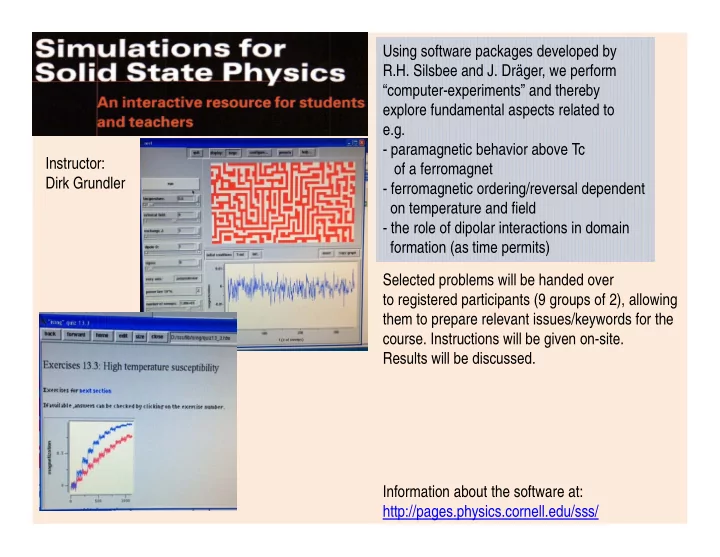

Using software packages developed by R.H. Silsbee and J. Dräger, we perform “computer-experiments” and thereby explore fundamental aspects related to e.g. - paramagnetic behavior above Tc Instructor: of a ferromagnet Dirk Grundler - ferromagnetic ordering/reversal dependent on temperature and field - the role of dipolar interactions in domain formation (as time permits) Selected problems will be handed over to registered participants (9 groups of 2), allowing them to prepare relevant issues/keywords for the course. Instructions will be given on-site. Results will be discussed. Information about the software at: http://pages.physics.cornell.edu/sss/
Problems for Simulations on ”Basic aspects in magnetism” Prof. D. Grundler ESM 2015 Computer Practical - Computer-based experiments Problem I: Temperature and field dependence of magnetization M in 2D Ising model Start PRESET #1 of ISING and then test different temperatures T > 3 J, magnetic fields H and different combinations thereof. What do you observe for magnetization M ( H, T )? Do you ’measure’ different magnetization values starting from different initial states (e.g., disordered ( T = INF), ordered ( M = 1), without initialization after a previous program run) for a given set of parameters? Why does the absolute value of averaged magnetization M increase as the temperature is lowered for H ̸ = 0? Please write down parameters and notes (’lab book’) when you perform the ’experiments’ on your computer with different parameter sets. Problem II: Exploration of temperature-dependent M in the paramagnetic regime Start PRESET #2 and test different EXTERNAL fields H of 10; 20; 30; 40; 50; 60; 70; 80; 90; 100 J. (a) How does the magnetization value develop as a function of the EXTERNAL field H ? (b) Compare with M ( T ) = tanh ( H/T ) predicted for a paramagnet with a two-level spin system! Does the observed M ( T ) deviate from this? Explain why. Problem III: Magnetization M ( T ) for a ferromagnetic state at low T Start PRESET #3. (a) Take M ( T ) data in a temperature range where the magnetization is in the range 0 . 3 < M < 1! How do the measured values deviate from M = 1 in the low temperature regime? Please read out the averaged values of M with the cursor set to the center of the noisy band of values and keep the left mouse button pressed down. This will give better values for the evaluation. 1
(b) Compare with a deviation [ M (0) − M ( T )] following a law exp − A/T (with A being a fitting parameter)! Why do you find such a behavior and not a law scaling with T 3 / 2 as originally suggested by Bloch for a ferromagnet? Problem IV: Nucleation and reversal PRESET #5 of ISING can be used to follow the creation and stability of a nucleus of reversed moments for reversal. Test different fields H between − 0 . 1 and − 0 . 05. What do you observe? How can one explain that a nucleus becomes stable initiating the complete reversal (consider gain in Zeeman energy and cost in terms of exchange energy: how do these scale with N ′ , i.e., the number of flipped spins in a nucleus)? 2
Notes: If you bring squared paper, pencil, calculator, or own computer with appropriate software (origin, Igor, excel, …), this would allow you to perform own data analysis. Intermediate results and data ‘measured’ with the software can be stored and copied. Please make use of such functionality if needed. Before running the program and taking a data set be sure to define the correct initial state for the ‘experiment’. In the following we provide some information on the software modules Ising and Néel. The problems listed above address the module Ising. We will leave some time at the end of the practical to test some aspects with Néel (Néel includes dipolar interaction that is not considered in Ising). Ising: 2D Ising model implemented, simulations based on the Monte Carlo method
Examples: ½ J
source: https://www.fh ‐ muenster.de/el ‐ labor/downloads/papier.jpg
Source: https://de.wikipedia.org/wiki/Logarithmenpapier
Recommend
More recommend